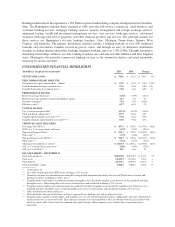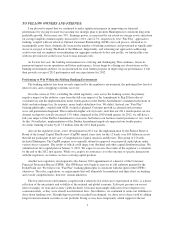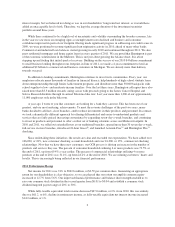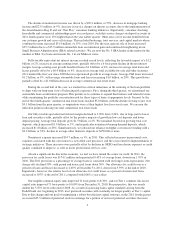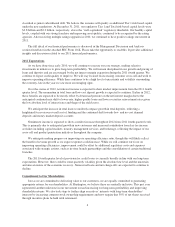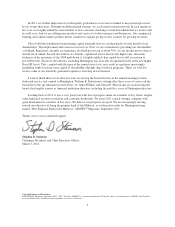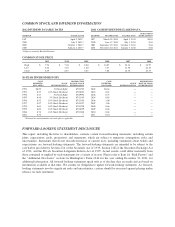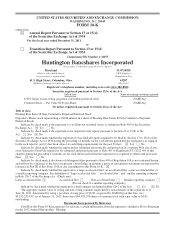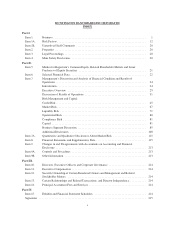Huntington National Bank 2011 Annual Report Download - page 3
Download and view the complete annual report
Please find page 3 of the 2011 Huntington National Bank annual report below. You can navigate through the pages in the report by either clicking on the pages listed below, or by using the keyword search tool below to find specific information within the annual report.
TO FELLOW OWNERS AND FRIENDS:
I am pleased to report that we continued to make significant progress in improving our financial
performance by staying focused on executing our strategic plan to position Huntington for consistent long-term
profitable growth. Net income rose 74%. Earnings power, as measured by our return on average assets and return
on average tangible common equity, increased to 1.01% and 12.7%, respectively. Our “Fair Play” approach to
banking, coupled with our effective Optimal Customer Relationship (OCR) cross-sell process, allowed us to
meaningfully grow loans, dramatically increase the number of banking customers, and positioned us significantly
closer to our goal of being The Bank of the Midwest. Importantly, and reflecting our approach to addressing
credit issues and an emphasis on maintaining our aggregate moderate-to-low risk profile, we finished the year
with our provision for credit losses back to near normal levels.
As I wrote last year, the banking environment was evolving and challenging. This continues. Given its
paramount impact on our operations and future performance, let me begin by offering my observations on the
banking environment and how we are positioned for even further progress in improving our performance. I will
then provide a recap of 2011 performance and our expectations for 2012.
Positioning to Win Within the Shifting Banking Environment
The banking industry has been severely impacted by the regulatory environment, the prolonged low level of
interest rates, and a struggling economic recovery.
Over the course of 2011, excluding the added regulatory costs across the banking system, the primary
negative impact on the industry came from the full-year impact of the Amendment to Reg E that reduced
overdraft fees and the implementation in the fourth quarter of the Durbin Amendment’s mandated reductions in
debit card interchange fees. In response, many banks added new fees. We didn’t. Instead, our “Fair Play”
banking philosophy, coupled with OCR, worked as planned. Customer growth accelerated and customer
cross-sell penetration deepened. This resulted in higher activity levels, such that our 2011 fourth quarter service
charges on deposits actually increased 13% when compared to the 2010 fourth quarter. In 2012, we still have a
full-year impact of the Durbin Amendment to overcome, but believe our business model positions us very well to
do this. Nevertheless, implementation of the Durbin Amendment negatively impacted our fourth quarter
electronic banking revenue by $17.3 million from the 2011 third quarter.
Also on the regulatory front, a new development in 2011 was the implementation by the Federal Reserve
Board of the formal Capital Plan Review (CapPR) annual stress tests for the 12 banks over $50 billion in assets
that did not participate in last year’s Comprehensive Capital Analysis and Review. This group of 12 banks
includes Huntington. The CapPR requires us to annually submit for approval our proposed capital plans under
various stress scenarios. The results of which could impact our dividend and other capital distribution plans. We
submitted our first capital plan on January 9, 2012. We expect to receive the results of the regulator’s evaluation
by the end of the 2012 first quarter. While we can give no assurances as to the outcome or specific interactions
with the regulators, we believe we have a strong capital position.
Another new regulatory development is the January 2012 appointment of a director of the Consumer
Financial Protection Bureau (CFPB). The CFPB may now begin to exercise its full authority granted by the
Dodd-Frank Act. We believe our “Fair Play” banking philosophy is consistent with the spirit of the CFPB’s
objectives. The rules, regulations, or requirements that will ultimately be mandated, and their effect on banking
and overall competitiveness, however, remain unknown.
The low interest rate environment, coupled with a relatively flat yield curve experienced in 2011, is a direct
reflection of the uncertainty and volatility of the national and global economy. It also put pressure on our net
interest margin. As loan and security yields declined, it became increasingly difficult to lower deposit costs
commensurately, as they were already near historical lows. Nevertheless, we continued to remix our liabilities to
drive down funding costs. Though deposit growth exceeded loan demand, we chose not to chase yield by adding
longer-term investment securities to our portfolio. Doing so may have temporarily added support to the net
1


